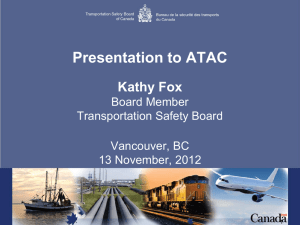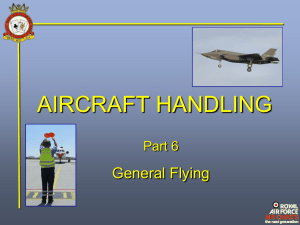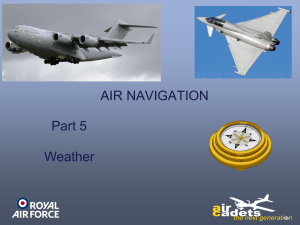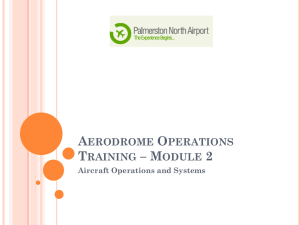12-13 The Circuit The Take Off Circuit And Land
advertisement
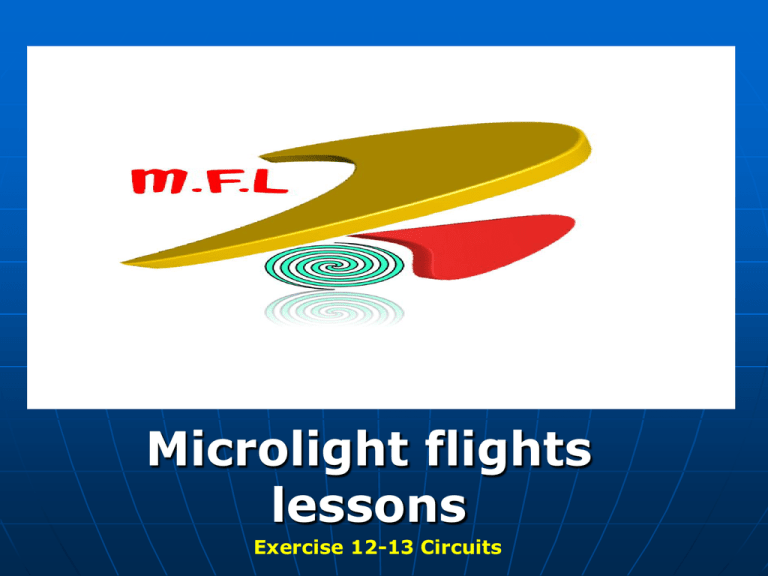
Microlight flights
lessons
Exercise 12-13 Circuits
12-13 The Circuit
The Take Off Circuit And
Land
Aim
To safely take off and climb the aircraft into a
position on the downwind leg at circuit height.
Also to land safely in the event of engine failure
after take off or at any time in the circuit, and to
decide against and take appropriate action if for
some reason continuation of the take off would
be un-safe
To fly an accurate circuit
and carry out a safe
missed approach
This exercise cannot be fully covered
in one flight exercise. It is broken down
into a number of briefings and flights.
Plenty of practice will be required to
build up the skills to solo standard
The Circuit
Active
side
Microlight flights
lessons
Into wind take off
THE STANDARD INTO WIND TAKE OFF
1. Checks complete, clearance obtained, line up and select a
2. Brakes off, apply smooth power
3. Keep wings level and bar neutral, keep steering straight
with nose wheel- not by steering with wing.
reference point well ahead. If the runway is short select abort
point.
4. As flying speed is approached smoothly move the bar
forwards to take off
Checks
During the take off run aurally check that full power has been
achieved, if in doubt abort the take off. Also estimate the expected
take off point for the prevailing conditions.
The Climb Out
Microlight flights
lessons
Into wind Glide approach
The Standard into wind glide approach and landing
1.Turn Finals line up on the extended runway centre
line make sure nose wheel straight
2.When you intersect the gliding angle towards your
chosen aiming point, lower the nose adopt the glide
3. Attain correct approach speed
Look well ahead down
runway to maintain
perspective
20ft
Hold off
Ground effect
Half Wing span
•
7. once on the ground keep steering straight and brake
gently only if necessary. Re-turn the bar to the neutral
position. On the smooth surface aerodynamic braking may
be used by moving the bar back from the neutral position
Microlight flights
lessons
Cross wind
THE CROSS WIND TAKE OFF
AND LANDING
1. Estimate the cross
wind component
And ensure it is within
limits check the pilots
hand book. P.O.H
15 degree off runway heading= crosswind
component ¼ of the wind strength
30 degrees off runway heading= cross wind
component ½ of the wind strength.
45 degrees off runway heading= cross wind
component¾ of the wind strength
60 degree or more off the runway heading=
cross wind component 1/1 of the wind
strength
Keep steering straight start
the run with the into wind
wing slightly down as airspeed
builds level wings
A cross wind will cause drift
after take off, so lift off
cleanly. Hold the aircraft firmly
on the ground during the take
off run then lift off cleanly and
positively
Once the aircraft lifts off it will
yaw into wind . Do not resist
this but keep the wings level,
the aircraft will assume
approximately the correct drift
angle. Adjust slightly if
required once the aircraft is
established in the climb. To
maintain runway centre line
Crosswind landing
1.
2.
3.
4.
5.
Land into wind if possible if
notEstimate cross wind
component as before ; ensure
within limit if not land
somewhere else.
Turn onto finales allowing for
head or tailwind on base leg
and get established on the
runway centre line allowing
for drift
Check nose wheel straight
Increase airspeed slightly
above for normal approach.
This will reduce drift angle
Continued crosswind landing
6. Round out slightly lower than normal,
make short hold off try to land on back
wheels with bar slightly forwards of trim to
keep airspeed up and reduce drift angle. if
difficult conditions turbulent may be useful
to carry a little power to keep airspeed up
and prolong the hold off.
7.Touch down back wheels first will yaw
straight on runway, try to hold nose wheel
up and touch nose down gently
8.
Lower into the wind slightly and keep
steering straight.
Some trikes can land flat . As the aircraft
lands it often will not be straight and tends
to snatch and track in the direction that the
trike is pointing . This can be reduced by
aligning the nose wheel with the direction
that the aircraft is tracking [down the
runway hopefully] As the aircraft touches
down it will then align with the tracking
direction and the nose wheel can be
straightened.
Do not use this technique on aircraft that touch
down main wheels first with nose wheel
well in the air
Airfield considerations for cross wind
landings with possible turbulence of
hangers
The turbulence
crossing hangers
can throw a trike it
can sink or cause
wing drop possible
stall be aware at all
times
Microlight flights
lessons
Short field take off
Take off
The short field take off is a procedure which is carried out when
obstruction clearance on take off is considered critical. The object
being to obtain the shortest take off distance and achieve the steepest
angle of climb
IF IN ANY DOUBT
If in any doubt whether obstacles
can be cleared safely do not attempt
to take off in the first place de-rigg
and trailer to a safe site or home or
wait until better weather conditions.
There is always another day to fly
safety first
Microlight flights
lessons
Short field landing
Short field landing
Microlight flights
lessons
Soft field take off
.
Soft surfaces sand boggy or long, wet grass usually
reduce the aircraft’s acceleration during the takeoff roll
so much that adequate take off speed might not be
attained if normal take off techniques were employed
Front wheel digging in
Take Off
1. During the take off hold the bar fully forwards
2. Lift as soon as possible {at a lower speed than normal}
3. Hold the aircraft close to the ground in the level attitude and
using the ground effect accelerate to a safe climbing airspeed
before adopting the climbing angle
Microlight flights
lessons
Soft field Landing
Landing
1.
2.
3.
4.
5.
When the landing surface is sift or the grass is long, the approach
should be set up in the normal way, for a power or glide approach
The touchdown should be made softly at the minim possible ground
speed therefore land as close as into he wind and hold off as fully as
possible touch down at the lowest possible airspeed
During the ground roll keep the control fully forwards o stop the nose
wheel from digging in.
Do not use brakes.
If the field is very soft, stop the aircraft, get out and walk the field
before taxiing
Microlight flights
lessons
Missed approach go around
Aircraft
obstruction
1.
2.
3.
4.
5.
Missed approach go Around
Reasons
Runway obstruction
Overshooting
Too close behind another landing aircraft
Strong turbulence or poor pilot control
Making continuation of landing will make
it unsafe
Aircraft
taking off
1.
2.
3.
4.
5.
6.
7.
Make the decision early
Open the throttle fully
Raise the nose
If runway obstructed by
another aircraft taking off
,move
Of runway and fly parallel
On airfields with no dead side
move to the live side but
beware of the other aircraft
turning across you
If all clear and at circuit
height, at the upwind leg of
the runway turn on to the
cross-wind leg and rejoin the
circuit on the down wind leg
1
Microlight flights
lessons
Circuit Emergencies
Engine failure at low level
Abandoned take off
1. Close throttle and bar neutral in pitch
2. Brake firmly if short distance
Engine failure after take off
Failure at very low level (10ft)- Use accurate pitch control to bring
aircraft down to hold off height and land ahead
Failure at 50 to 100ft- lower nose to glide attitude immediately and
land ahead
Engine failure at 50 to 100 feet
Engine failure
after take off
Take off roll
Lower nose
to glide
angle
Land
Ahead
Failure at 200ft to 300ft
Failure at 200 to 300ft –lower nose to glide angle
immediately. Land straight ahead if possible. If runway
is insufficient and large obstacles make landing
beyond dangerous, either S turn to bring the landing
point closer. or turn to land cross wind in a clear area
DO NOT ATTEMPT TO TURN BACK-unless at least 500feet
Agl and the end of the runway is still underneath the
aircraft or very close behind. Do not attempt to land
downwind unless wind is extremely light
Engine failure in circuit
1.
2.
3.
4.
Lower nose and adopt
the gliding attitude
for minimum sink.
Pick the safest
available landing area
and position to land
into wind.
Do not attempt to
make it back to land
at the aerodrome
unless it is the safest
option
Prepare for this by
noting suitable
landing areas before
the engine stops and
mentally rehearsing
the procedure for
every position around
the circuit
Aborted landing
If you land longer than expected and
doubt exists on whether you will be
able to stop before the end of the
runway, try to make an early decision
and apply full power promptly and
take off again. If there is not enough
runway left then brake firmly( wheel
and aerodynamic braking) Switch off
the ignition and gently steer away
from obstacles
1
Microlight flights
lessons
Departing and joining the circuit
Departing
Joining
Down wind join
If the runway in use and circuit direction is
ascertained prior to entering the ATZ a
downwind join may be used.
1.On the initial approach to the Aerodrome keep to the
upwind side
2. Aim to be established on the down wind leg abeam
the upwind end of the runway. Approach this
position ideally at 45 degrees to the downwind leg.
Keep a very good lookout and give way to aircraft
already established on the circuit
Base leg and Final join
Circuit Airmanship
Plan Ahead
Lookout
Right of way
Wake turbulence
Checks
Handling
